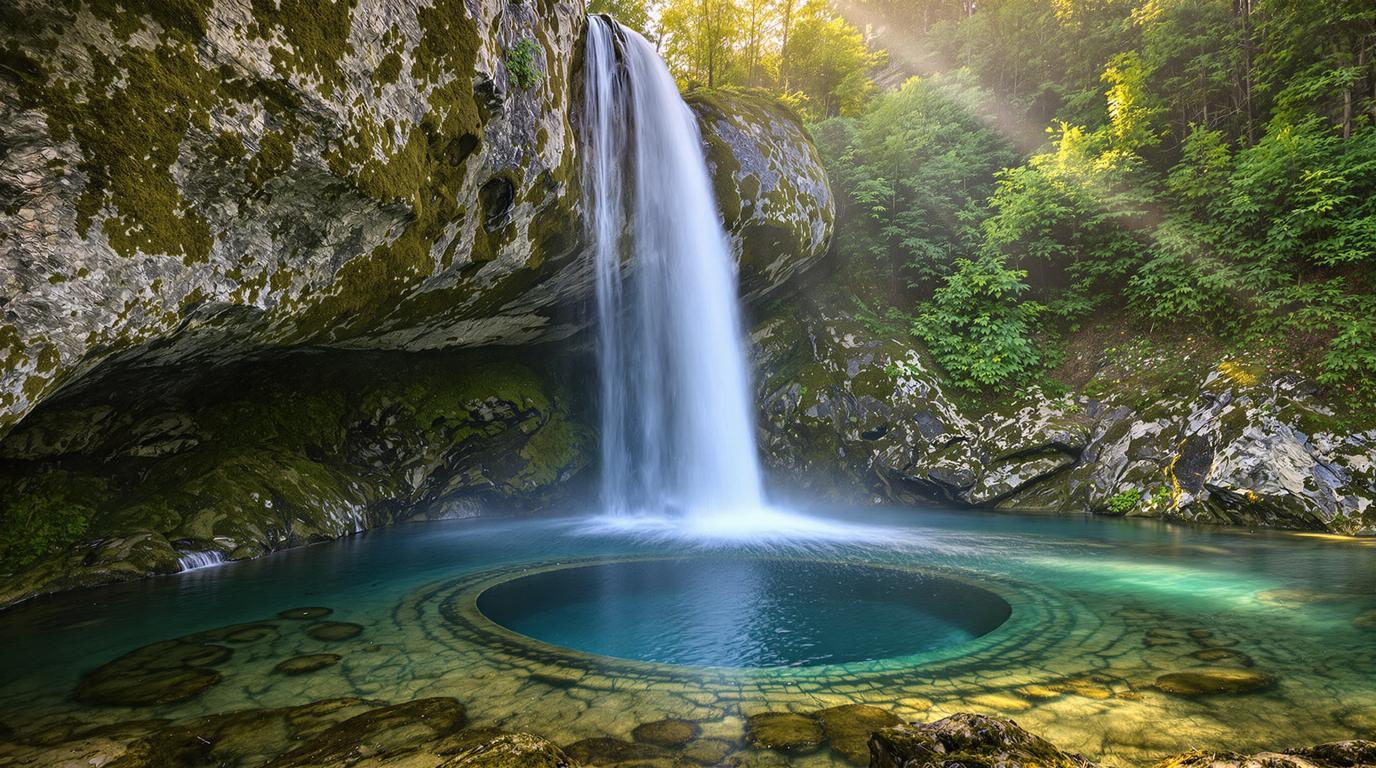Water doesn’t simply fall at Cascade des Combes – it emerges from solid rock like a mountain weeping. Standing beneath this modest 8-meter cascade in France’s Jura region, I found myself mesmerized not by its height but by its impossible origin. Unlike most waterfalls that tumble over cliffs, here the Ruisseau de l’Abîme stream mysteriously appears from within the limestone wall itself, creating an optical illusion that’s captivated visitors for centuries.
Where poets found inspiration in water emerging from stone
Tucked just minutes from Saint-Claude in eastern France’s Bourgogne-Franche-Comté region, this photogenic waterfall remains surprisingly overlooked by international travelers. Alphonse de Lamartine, the celebrated 19th-century French poet, reportedly found creative inspiration in its unique ambiance – the strange quietude of water appearing from solid rock.
“This place has what we call ‘l’allure de fin du monde’ – an end-of-the-world feeling that gives you a pronounced sense of escape,” explains Mathieu, a local hiking guide I encountered. “People come seeking grand cascades elsewhere but miss our small treasure with its peculiar magic.”
What makes this site extraordinary isn’t just the waterfall but the glacial potholes carved into the riverbed below – perfect circular depressions formed over millennia by stones swirling in the current.
Three hidden corners that reveal Jura’s secret character
A forest path leading to geological wonder
From the small parking area along road D69 (GPS: 46.402728, 5.878545), a 15-minute descent through dappled forest light leads to the cascade. Unlike popular tourist sites with manicured trails, this path retains a wild charm, occasionally slippery after rain but always rewarding with its sense of discovery. While most visitors photograph only the main waterfall, following the stream another 50 meters reveals those remarkable glacial potholes – some nearly a meter wide.
The unexpected island of tranquility
Just beyond the cascade lies a little-visited picnic area where massive moss-covered boulders create natural seating beside the stream. On even the hottest summer days, the temperature here drops noticeably. I spent a blissful hour watching light filter through beech leaves, creating dancing patterns on the emerald-tinted water while enjoying complete solitude – despite the main waterfall area hosting several families.
Gorges de l’Abîme’s secret extension
While most visitors complete only the standard 2km loop trail, few continue toward what locals call “the forgotten bridge” – an ancient stone crossing dating to the 18th century. This extension reveals medieval craftsmanship similar to those found in France’s UNESCO villages, yet remains virtually unphotographed compared to the main cascade.
A culinary tradition born from mountain isolation
Just five minutes’ drive from the cascade, the unassuming Fromagerie Janin offers something remarkable – Bleu de Gex cheese made using methods unchanged since the 14th century. Unlike industrial versions, their small-batch production captures the essence of alpine meadows in every creamy, slightly peppery bite. Paired with the region’s distinctive vin jaune (yellow wine), it creates a flavor combination impossible to experience elsewhere.
For the truly adventurous, ask about their “hidden cellar” tasting – an appointment-only experience where visitors sample cave-aged specialties beneath centuries-old stone vaults, including cheeses never exported beyond the Jura.
Essential insights for the curious traveler
Timing transforms the experience
Visit after recent rainfall when water volume dramatically increases, transforming the modest cascade into something far more impressive. Early mornings (before 9am) offer the best photography light and near-guaranteed solitude. Weekends see significantly more visitors, particularly between 11am-3pm.
Practical access considerations
The small parking area fills quickly during summer months, but a larger alternative exists at the Gorges de l’Abîme lot across the road. The access path becomes quite slippery after rain – standard hiking shoes suffice in dry conditions, but proper hiking boots prove essential during wet periods, much like when visiting France’s wilder coastal areas.
For travelers without a vehicle, the #7 local bus from Saint-Claude stops near the trailhead (spring through fall only), though service is limited to 3-4 daily departures.
Where water teaches patience to the observant
As daylight faded on my final visit, I noticed something extraordinary – the cascade’s sound changes with falling light. What begins as a bright, energetic splash in sunshine transforms into a deeper, more resonant murmur at dusk, as if the mountain itself is exhaling. In our rush to see the world’s grandest waterfall spectacles like Africa’s thundering Victoria Falls, we sometimes miss the profound beauty of water’s more intimate conversations with stone – a dialogue Cascade des Combes has perfected over countless millennia.
